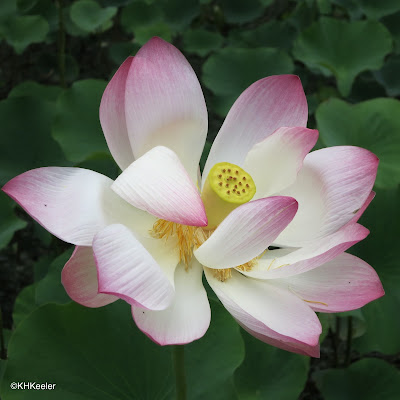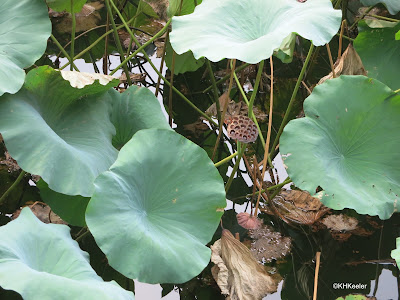Buddha's imagery is an accurate description of the life of lotus plants.
Lotus, also called the sacred lotus, Nelumbo nucifera (lotus family, Nelumbonaceae) has been grown across Asia for millennia. Not just beautiful, it is an important food plant. The leaves, rhizomes ("roots') and seeds are edible (link).
Lotuses grow happily in deep mud. The lotus pond is likely to be a stinky spot which will cover you in thick, reeking mud if you venture there.
 |
| Lotus pod in pond mud in February. |
Lotus is an ancient plant. Recognizeable fossils date back to the Age of Dinosaurs (upper Cretaceous). But it went extinct in large parts of the world and its current distribution undoubtely reflects its importance to humans.
Lotuses are unique. Only two living species are recognized and those are the sole members of the plant family Nelumbonaceae, the lotus family. One species of lotus, Nelumbo lutea, is native to North America, although they are not well-known to North Americans. In Asia, everyone knows the other species of lotus, the sacred lotus, Nelumbo nucifera.
Under growing conditions they like, sacred lotuses can spread rapidly. In India, for example, when the rains fill dry lowspots, the return of lotus from mud-buried rhizomes can be so fast as to seem miraculous.
The leaves can be a yard (meter) across.
The flowers are insect pollinated and have an attractive smell. The flowers of sacred lotus range from white to pink to red to pale yellow. Nelumbo lutea, the American or yellow lotus, has yellow flowers.
The sacred lotus is tropical, tolerating frost only if it is growing in deep enough water so that it doesn't freeze. As a rooted aquatic, the lotus needs to grow from the mud on the bottom to the surface, so really deep ponds are too deep for it to reach the surface. The result is that you don't generally find sacred lotuses in cold climates. However, they have been cultivated for millennia. Bringing the plants indoors in winter or replanting in the spring will allow them to be grown in most places. In the foreground below is a clump of lotuses rising out of their pots in the aquatic garden at the Denver Botanic Garden in 2014.
 |
| Lotus, Denver Botanic Garden |
The sacred lotus is so dramatic and beautiful that it is an important religious symbol to Buddhists, Hindus, Jains, Taoists and Shintos (and probably others). Scholars suspect that the mother goddess of the people of India before the Aryans arrived had lotus as her symbol. Native American found mystic powers in the equally glorious American lotus. (American lotus picture 1 2 )
 |
| sacred lotus |
That image: the lotus rising out of the muck, spectacularly beautiful, is an easy one to cherish. The lotuses repeat it in pond after pond, year after year.
References
Bynum, H. and W. Bynum. 2014. Remarkable Plants that Shape Our World. University of Chicago Press, Chicago.
Gupta, S. M. 1996. Plants in Indian Temple Art. B. R. Publishing Corporation, Delhi.
Nelumbonaceae. Stevens, P. F. 2001 onwards. Angiosperm Phylogeny Website. Version 12, July 2012 [and more or less continuously updated since]. http://www.mobot.org/MOBOT/research/APweb/.
Nelumbo lutea. Missouri Plant Finder. Missouri Botanicial Garden. link
Vaughan, J. G. and C. A. Geissler. 1997. The New Oxford Book of Food Plants. Oxford U. Press, Oxford.
Buy the Book! Give it as a gift! This story and thirteen other plants from around the world are told in Curious Stories of Familiar Plants from Around the World. Available on Amazon link.
Kathy Keeler



hello thanks for sharing this blog
ReplyDeleteThe blossoming top of the sunflower tracks the sun's development, abandoning east to west during the day, a wonder known as heliotrope.
regards
garden